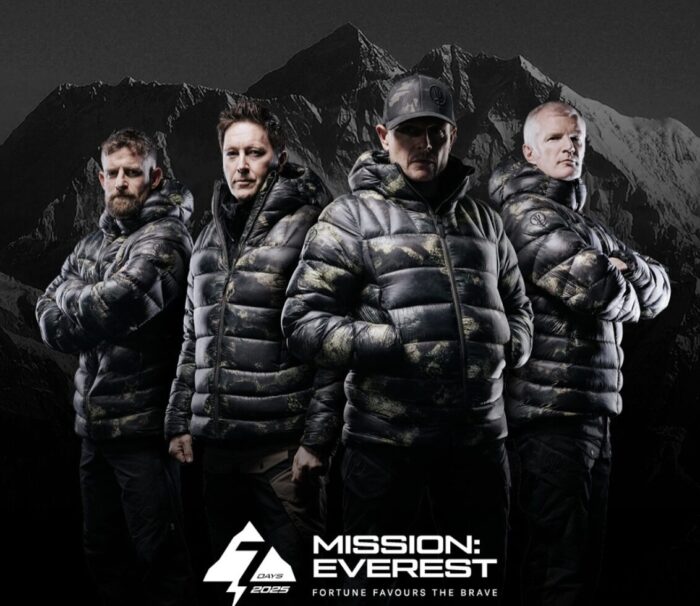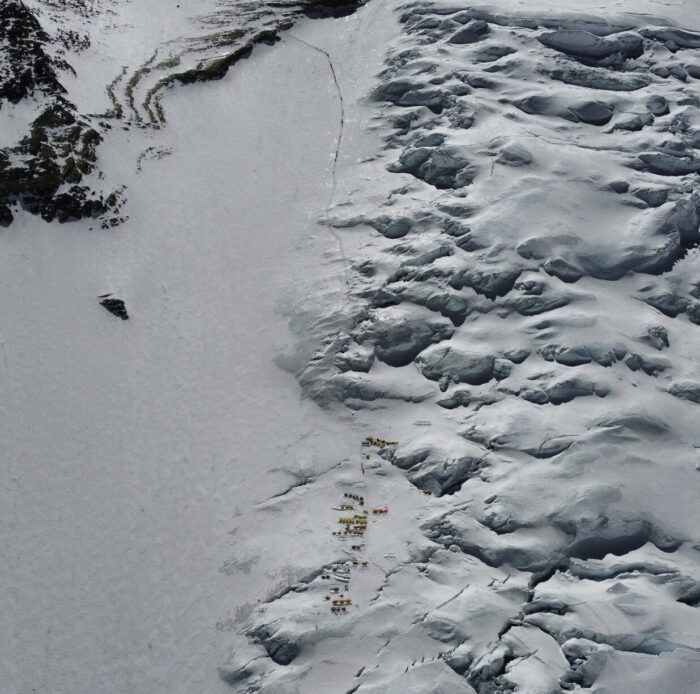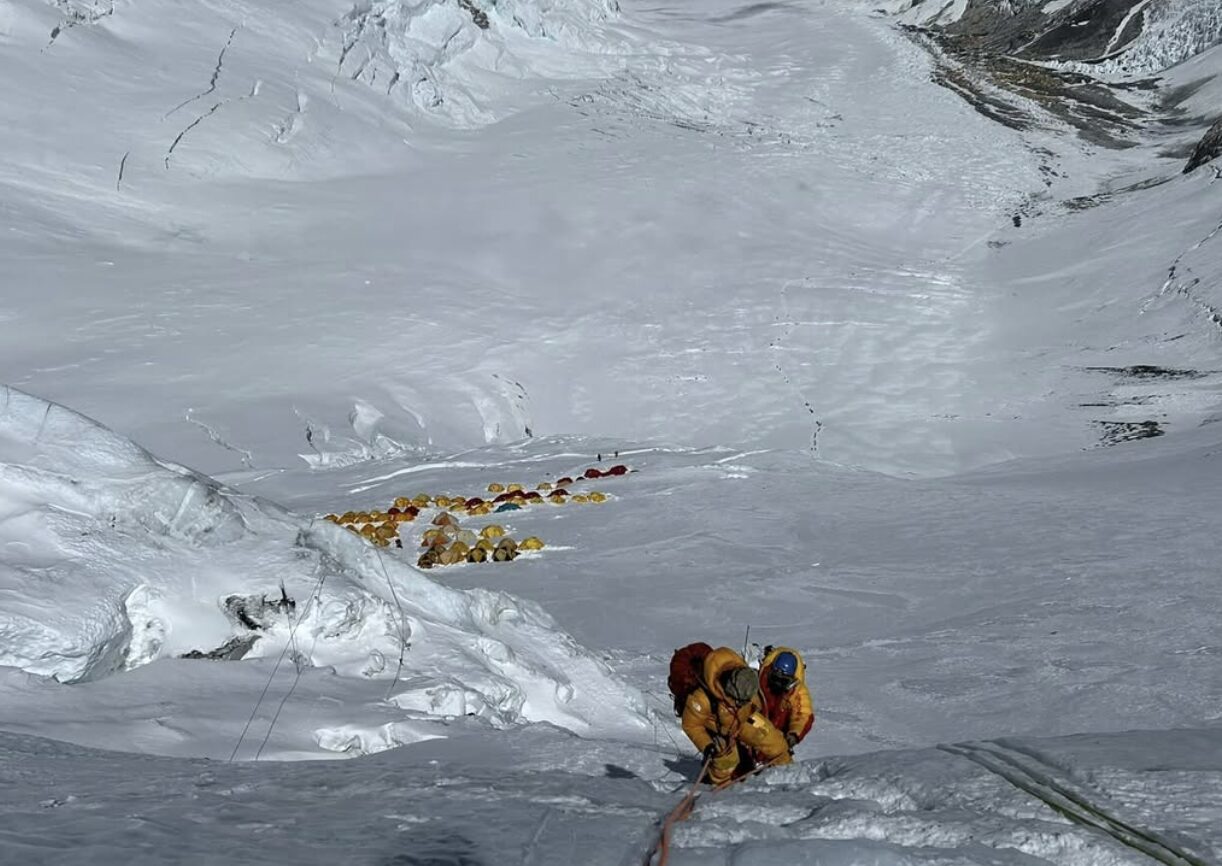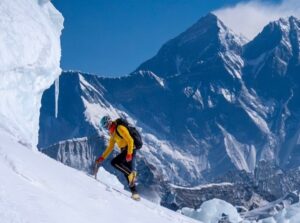The four men who want to climb Everest in seven days door-to-door made Camp 3 on Monday. Today, they have reached Camp 4, just four days after leaving the UK.
However.
The jet stream is hitting the mountain hard, and forecasts expect this will continue for at least two or three more days. So will the team, which helicoptered to Everest Base Camp on Friday, make their ambitious deadline?

Expedition poster for the one-week Everest expedition. Photo: Instagram
Furtenbach’s personal project
The team comprises four British ex-military — Garth Miller, Alastair Carns, Anthony Stazicker, and Kev Godlington. However, the idea and strategy are Lukas Furtenbach’s eight-year personal project. The head of Austria-based Furtenbach Adventures told ExplorersWeb that he is confident of the expedition’s success.
“We have the climbers in the right position at C4 for a summit climb as soon as the conditions allow,” Furtenbach said from Base Camp. “We have access to the best weather models and meteorologist, as well as the best logistics on the mountain. We will find our window.”
The logistics included over 500 hours of hypoxic training to pre-acclimatize. The members slept in a hypoxic tent and trained with a mask on. Special regulators on the mountain will increase their oxygen flow. Finally, they used a new technique that has stirred a debate among the mountaineering community: They breathed Xenon gas before heading to the mountain.
The Xenon weapon
“We had the 30-minute Xenon therapy in a hospital in Germany,” member Garth Miller told ExplorersWeb from the airport. “Xenon has neuro-protective qualities which research indicates [will make us] less susceptible to AMS [Acute Mountain Sickness],” particularly cerebral edema.
Miller explained that the Xenon complements their other pre-acclimatization. “Using Xenon won’t make us go faster, but it will mean that we can go high faster without the risk of AMS.”
He also pointed out that while the World Anti-Doping Association bans Xenon in competitive sports, acetazolamide (Diamox), supplemental oxygen, and dexamethasone are also banned, yet all three are the norm on 8,000m peaks.
No time to lose
The team is ready to use every technology to achieve their target speed. While this has many critics in the climbing community, the members have a different point of view:
“We are all busy professionals with families. It simply wouldn’t be possible for us to take the traditional seven to eight weeks out of our lives, away from our families and work, to do a ‘normal’ Everest expedition.”
Miller himself has summited Everest twice before.
“My first expedition to Everest was over 20 years ago — a traditional 70-day epic,” he said. “I cut that dramatically to 21 days ‘door-to-door’ from London in 2022 by taking advantage of pre-acclimatization.”
Then Furtenbach told Miller about his project, and the expedition was born. “We are building on that experience,” Miller said.
Miller noted all team members are experienced mountaineers, but he is the only one with previous experience above 8,000m. He also points to their military backgrounds as a positive asset.
“We are all very used to balancing risk and pushing ourselves to the very limit physically and mentally. We are treating this like a military operation — meticulous preparation and planning followed by bold execution.”
Echoes of Project Possible

The Lhotse face, with the tents of Camp 3 and a line of climbers progressing up the Face and to the left, toward the Yellow band. Photo: Furtenbach Adventures
By climbing the 14×8,000’ers in a year, Purja became a celebrity and influenced how the expedition industry developed its logistics. For Furtenbach, the faster and more supported an expedition is, the safer.
The Austrian guide has often criticized alpine-style advocates who tackle difficult routes on technical mountains. In a recent article, Furtenbach compared alpinists to modern-day gladiators who “eschew safety margins and embrace high personal risk,” which results in “accidents, fatalities, and near-misses…in large numbers and with alarming regularity.”
Who wants to be an alpinist?
Obviously, the team is missing out on the travel and cultural side benefits that a standard Himalayan expedition provides. They will not feel the real effects of extreme altitude on their bodies like Reinhold Messner and others did. They are playing a much less dangerous game. But that might be exactly what most 21st-century Everest climbers want.
While some roll their eyes at the Xenon climbers, many potential clients who value their time (and safety) and yet want an Everest summit on their resumés are paying close attention to how this expedition unfolds.
The good news for them is, the team’s progress can be tracked live on Twitch through the expedition website.






